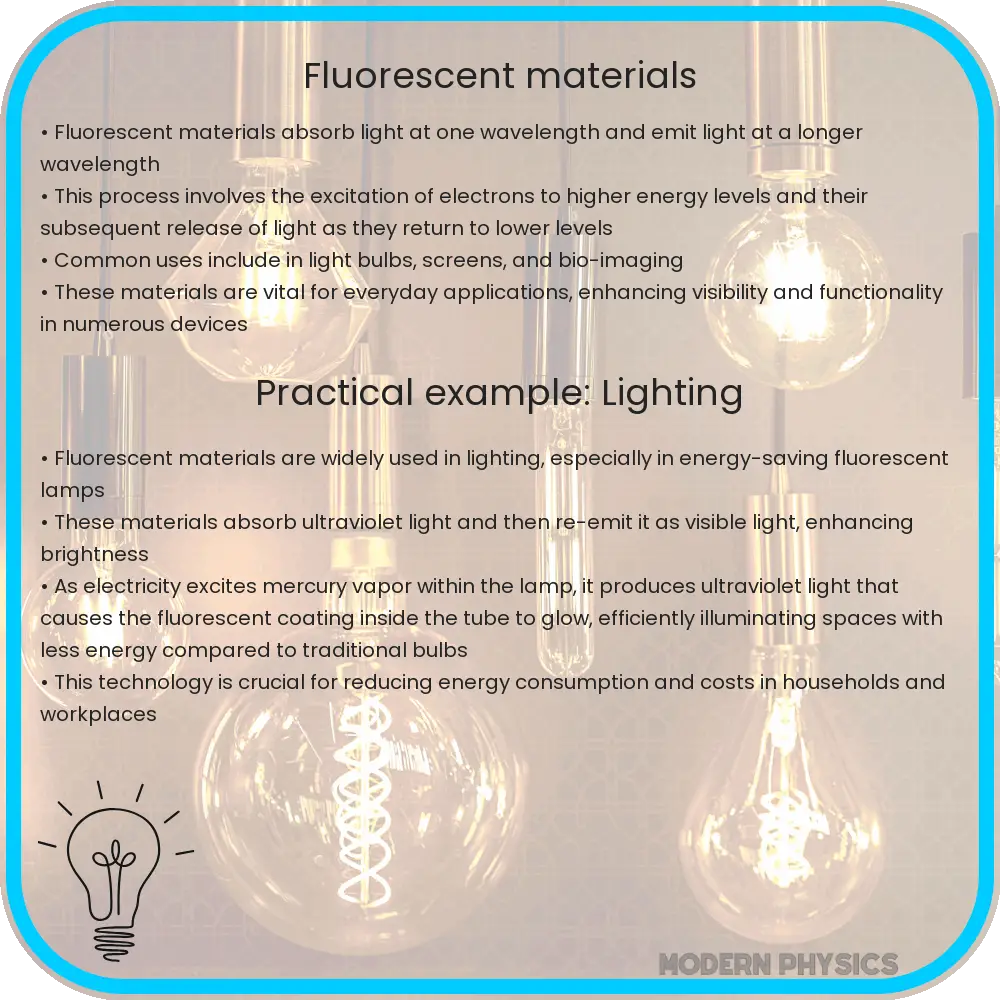Learn about fluorescent materials, substances that absorb light at one wavelength and emit it at another, used in safety gear and more.

Understanding Fluorescent Materials
Fluorescent materials are a fascinating subject of study in both physics and materials science. These materials have the unique ability to absorb light at one wavelength (or color) and emit light at a different wavelength. This process, known as fluorescence, is what makes these materials particularly useful in a variety of applications, including safety, visibility enhancement, and even art.
The Science Behind Fluorescence
The phenomenon of fluorescence occurs at the atomic level. When light strikes a fluorescent material, it excites the material’s electrons, boosting them to a higher energy level. As these electrons return to their original energy state, they release energy in the form of light. This emitted light is typically of a longer wavelength, and thus lower energy, than the absorbed light.
For instance, if a fluorescent material absorbs invisible ultraviolet light, it might emit visible light in bright colors such as green, yellow, or red. The specific colors emitted depend on the material’s properties, particularly the types of atoms involved and the configuration of their electrons.
Applications in Visibility and Safety
One of the most recognizable uses of fluorescent materials is in high-visibility clothing, typically worn by construction workers, emergency responders, and cyclists. These materials are crucial for safety in low-light conditions, making the wearer significantly more visible than non-fluorescent materials would.
Fluorescent paints and tapes are also used to mark exits, stairs, and other critical areas in buildings to enhance egress safely during power failures or emergencies. These applications leverage the high luminance of fluorescent materials to create clear, visible signs and paths that are observable even in very low lighting conditions.
Enhancing Durability of Fluorescent Materials
While fluorescent materials are invaluable for visibility and safety, one of their challenges is durability, particularly under constant exposure to sunlight and other elements. UV radiation can degrade many fluorescent materials, leading to a loss of brightness and effectiveness over time.
To combat this, scientists and engineers work on various treatments and coatings to protect these materials. For example, incorporating UV stabilizers can prolong the lifespan of fluorescent materials used outdoors. Additionally, using robust materials as a substrate, such as durable plastics or ceramics, can help preserve the fluorescence characteristics while extending the overall life of the product.
Innovations in Fluorescent Technology
Recent advancements in technology have allowed for the development of new types of fluorescent materials. One area of innovation is in the field of quantum dots, tiny semiconductor particles that can fluoresce in a variety of bright colors. Quantum dots can be tailored during manufacturing to emit specific wavelengths of light, which makes them extremely useful for applications ranging from vivid displays to advanced diagnostics in medicine.
Furthermore, researchers are exploring organic fluorescent materials, which offer the potential for more environmentally friendly alternatives to traditional fluorescent substances, which often contain heavy metals and other toxic components.
Fluorescent Materials in Art and Design
Artists and designers have embraced fluorescent materials to add vibrancy and a touch of surrealism to their creations. These materials can transform an ordinary space into a dynamic visual experience, particularly under ultraviolet light. In the art world, fluorescent paints bring astonishing depth and intense colors to artworks, making them stand out in galleries and installations.
In the realm of interior design, these materials are used to create features that are both aesthetic and functional. For example, fluorescent materials integrated into furniture or textiles can enhance the ambiance of a space while providing essential lighting without additional energy costs.
Environmental and Health Considerations
Despite their widespread use, fluorescent materials are not without environmental and health concerns. The disposal of fluorescent materials, especially those containing toxic elements, requires careful handling to prevent environmental contamination. Regulatory measures and recycling initiatives are therefore important to manage the impact of these materials on the environment.
Healthwise, prolonged exposure to ultraviolet light used to excite certain fluorescent materials can pose risks. Therefore, appropriate safety measures, like protective eyewear and minimizing exposure, are recommended when working with or near ultraviolet light sources.
Conclusion
Fluorescent materials, with their unique properties of absorbing and emitting light, play an indispensable role in various fields ranging from safety and visibility to art and design. Their ability to transform invisible ultraviolet light into vibrant visible light makes them particularly useful in enhancing safety in low-light conditions, adding aesthetic value in art, and improving functionality in design.
While their benefits are significant, the challenges associated with durability, environmental impact, and health safety require ongoing attention. Advances in technology, such as the development of quantum dots and organic alternatives, continue to push the boundaries of what is possible with fluorescent materials. As we advance, balancing the functional use and environmental health remains crucial to the sustainable employment of these bright materials in our daily lives.
